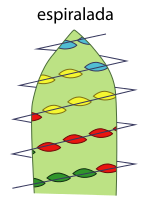Whorl
The whorl (from the Latin verticillum, 'tortera') is called the arrangement of three or more organs of a plant, such as leaves, flowers (petals, sepals, stamens or carpels), which sprout from the same node on the stem.
Plants with whorled leaves maintain this arrangement throughout their lives; they occur in species with short internodes, such as Aloysia citriodora, Nerium oleander, Brabejum stellatifolium and the genus Banksia (both in the family Proteaceae) and members of the Rubiaceae.
The organs that make up the flower of most angiosperms also have whorled organization (also called cyclic). Depending on the number of whorls, the flowers can be tetracyclic (4) or pentacyclic (5); and depending on the number of pieces contained in each whorl, they are called dimeras (2 pieces), trimeras (3 pieces), tetrameras (4 pieces), and pentameras (5 pieces). When there is only one piece arranged in each knot the flower is called "spiralada" or "acyclic".
Contenido relacionado
Anthenatia
Milk ducts
Calamovilfa





